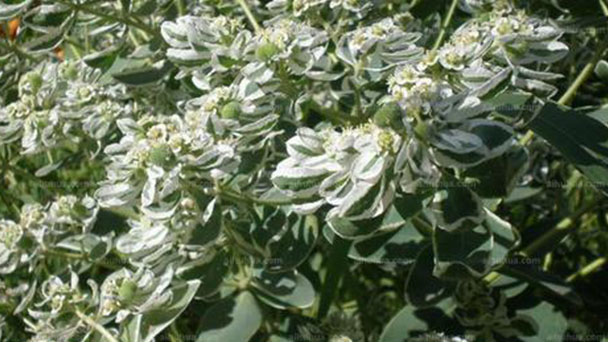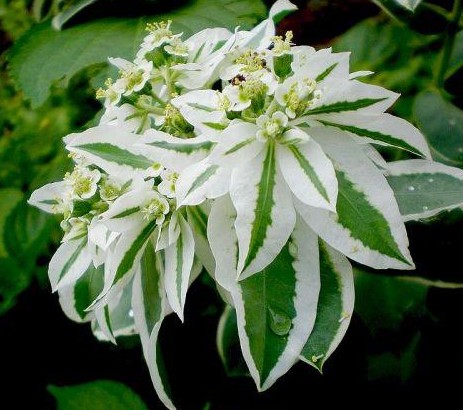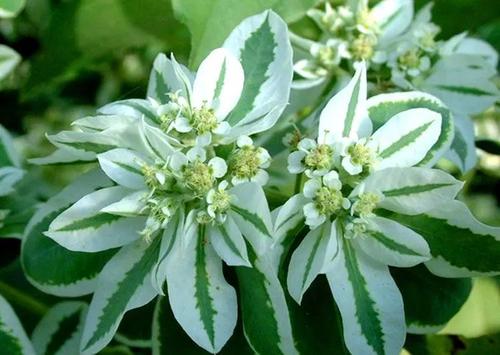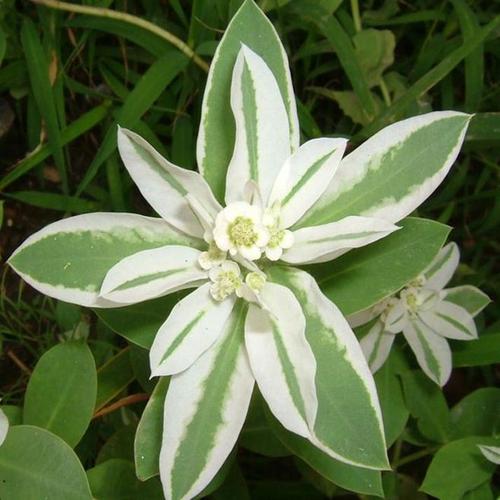Snow on the mountain (Euphorbia marginata) profile
Written by Maggie
Mar 29 2021

Snow on the Mountain, Latin Scientific name: Euphorbia Marginata Pursh, alias: Euphorbia Marginata Pursh, belongs to Euphorbia family and Euphorbia family, which can be planted in scenic spots, parks and gardens, as well as in flower beds, flower borders and clusters, as well as in forest margins and pot plants, and as cut flower materials. Snow on the Mountain likes warm sunny places, drought tolerance, not cold. The soil requirement is not strict, but loose fertile soil is better, and the flowering is prosperous. The parietal leaves are silvery white, set off with the lower green leaves, just like the Snow on the Castle Peak. If arranged with flowers of other colors, the beauty of color can be better played. Snow on the Mountain is a good flower bed background material, but also for flower arrangement with leaves.
Snow on the mountain picture

Morphological characteristics of snow on the mountain
Rhizome
Snow on the mountain is an annual herb. Roots are slender, very branched, up to 20 cm long, 3 -- 5 mm in diameter. Stem is simple, much branched from base upward, to 60 -- 80 cm tall, 3 -- 5 mm in diam., smooth, often glabrous, sometimes pilose.
Leaves
Leaves of Snow on the Mountain are alternate, elliptic, 5-7 cm long, ca. 3 cm wide, apex obtuse, apically apiculate, base truncate-rounded, green, entire; Sessile or nearly sessile; Involucral bracts 2-3, elliptic, 3 -- 4 cm long and 1 -- 2 cm wide, apex rounded, base tapered.
Umbrellas of Snow on the Mountain are 2-3 broad, 1-4 cm long, pilose or sub glabrous; Bracts are elliptic, 1 -- 2 cm long, 5 -- 7 (9) mm wide, apex rounded, base tapered, subsessile solitary in bracts or in several cymmoses, base petiolate, petiolate 3 -- 5 mm long, densely pilose;
Involucral bracts of Snow on the Mountain are campanulate, 5 -- 6 mm tall, ca. 4 mm in diam., externally pilose, margin 5-lobed, lobes triangular to rounded, acute to slightly concave, margin and medial pilose;Gland 4, semicircular, margin with broad white appendages, longer and wider than the gland. Male flowers are numerous, protruding outside involucre; Bracts are filiform; Female flowers 1, ovary stalks longer, 3-5 mm long, protruding beyond involucre, pilose; Ovary is densely pilose; Snow on the Mountain has 3 styles, detached; Stigma is 2-lobed.
Fruit
Capsule of Snow on the mountain subglobose, ca. 5.5 mm long and in diam., stipitate, 3 -- 7 mm long, pilose; Styles are persistent; The fruit divides into 3 mericarps at maturity. Seeds are terete, yellowish to grayish brown, 3.5 -- 4 mm long, 2.8 -- 3 mm in diameter. Tuberculate or spiny or inconspicuous protuberances;
Ecology of Snow on the Mountain
Snow on the Mountain likes warm sunny places, drought tolerance, not cold. The soil requirement is not strict, but loose fertile soil is better, and the flowering is prosperous.Flowering in late summer and early autumn.
Snow on the Mountain is an annual grass flower. The plants die before winter. When potted, the plants are moved into the greenhouse before winter, and they can live until the next spring. Snow on the Mountain requires sufficient sunlight, not tolerant to shade, high temperature, afraid of humidity. Because it is a rhizosphere plant, it requires a deep soil layer, drought resistance but not waterlogging resistance, in fertile soil in the thick branches and leaves, can not bear to be thin, can grow in the light alkaline soil.
How to grow and care for snow on the Mountain
Moisture
Snow on the Mountain likes high air humidity, and if the air humidity is too low, it will accelerate a single flower wither. Also afraid of rain, I need to keep the leaves dry at night. The optimum air relative humidity is 65 ~ 75%.
Temperature
Snow on the mountain like warm climate, avoid hot, in summer when the temperature is higher than 34℃ obviously poor growth; It is not frost resistant and enters dormancy or dies when the temperature is below 4℃ in winter. The optimum growth temperature is 15 ~ 25℃. It is generally planted in autumn and winter to avoid high summer temperatures.
Light
Spring, summer and autumn need to be conserved under shade conditions. When the temperature is higher (the daytime temperature is above 25℃), if Snow on the Mountain is placed in direct sunlight for maintenance, the leaf will become significantly smaller, the internode of the branches will be shortened, the foot leaves will turn yellow, fall off, and the growth will be very slow or enter a semi-dormant state. In winter, because the temperature is not very high, it is necessary to give Snow on the Mountain direct sunlight, in order to facilitate its photosynthesis and the formation of flower buds, flowering, fruiting. After the flowering period is maintained indoors for a period of time (10 ~ 15 days), it is necessary to move it outdoors to a place with shade (heat preservation) conditions for a period of time (about a month), so alternately, in order to help the plant to accumulate nutrients and continue to bloom.
Water
Like other grass flowers, Snow on the Mountain requires more fertilizer and water, but it requires to follow the fertilization (water) principle of "frequent application of light fertilizer, few times and more, and complete nutrition", and after fertilization, it is necessary to keep leaves and flowers dry at night:
Two seasons: spring, autumn is the two season it's peak season, water management, in accordance with the "flower", "flower" - water - "flower", "flower", the order of the water cycle (at the very least to ensure that the "flower" twice a week), interval period is about: outdoor maintenance of 1 ~ 4 days, sunny days or high temperature during every cycle short, rainy day or during the low temperature cycle longer insulation or not watering; Put Snow on the Mountain in the indoor maintenance of 2 ~ 6 days.
Summer: summer high temperature period is often into dormancy state, not much fertilizer and water requirements, and even to control water and fertilizer. Fertilizer and water management follows the sequence of "Huabao" -- clear water -- clear water -- "Huabao" -- clear water -- clear water. The interval period is about 3-5 days for outdoor curing and 4-7 days for indoor curing. The watering time should be arranged as far as possible in the morning when the temperature is low, and the leaves should be kept dry at night.Spray the plants often.

How snow on the Mountain propagates
Seed propagation
Snow on the mountain is often sown and bred. Sowing in April, generally open direct seeding, 7-10 days after sowing, germinate neatly. Seeds have the ability to self-sow and reproduce. Cuttage can also be used to breed, cut to be cut after dry and then inserted, otherwise cut mouth easy to rot.
Tachy Root plants, suitable for direct seeding and not resistant to transplantation. The suitable temperature for Snow on the Mountain germination is 18-20℃. Spring sowing in April to June when the seeds will be sown in the base fertilizer good loose soil, per square meter of seedbed seeding amount of about 150 grams, covering soil 1.2-1.5 cm, control ground temperature 20-25℃. Seedling can emerge within 8-10 days and grow at an appropriate temperature of 18-35℃. Snow on the Mountain is pleasant to a sunny warm climate environment, like fertile and well drained sandy loam, not cold, drought resistant, and avoids excessive moisture. To be transplanted in time after the emergence of seedlings, with a diameter of about 8 cm container seedlings. The temperature should be controlled at 20-25℃ during the day and 8-15℃ at night. The moisture should be controlled moderately and less. The flowers should bloom from July to October. Open cultivation generally consists of single plant seedlings. Place 3 seedlings into each container of potted plants so that they are full.Seedling days about 50 days, the last frost after transplanting.
Propagation methods seeding, cutting propagation, but the main seeding.
Cutting propagation
Cuttings in the growing season, cuttings must be cut out of the tender parts, and the growth is robust. The cuttings are about 10cm long, cut flat. The cuttings can be inserted directly into the soil to a depth of 3 ~ 4cm. Because the base stem of Snow on the Mountain contains emulsion, so after insertion can not be immediately watered, otherwise easy to lead to the insertion of part of the rot, but should wait for the emulsion to be sucked dry, before watering. Or before inserting dipping in plant ash, after inserting with plastic film to cover, put in a cool place, humidity above 95%, about 10 days can take root.
Disease control of snow on the mountain
Snow on the Mountain grows healthily and almost free of pests and diseases. It can fly between flower clump licks, suck the honey that the flower secretes, and can use 4 cm happy fruit emulsion 1 200 ~ 500 times liquid prevention and cure commonly.
The area of snow on the mountain
Snow on the Mountain is native to the grasslands of southern North America. Due to artificial cultivation, it is cultivated in most provinces and regions of mainland China and distributed in other places.
Snow on the Mountain uses
Medical use
Snow on the Mountain can extract poison and detumescence. For irregular menstruation, nameless swelling poison, bruised.
Ornamental value
Snow on the Mountain is native to North America and widely cultivated in the Old World; China's most provinces are cultivated, common in botanical gardens, parks and other places, for viewing. It is a good ornamental plant in summer, suitable for arrangement of flower bushes, flower beds and flower borders, and can also be used as vacant land for greening. The parietal leaves are silvery white and set off with the lower green leaves. Snow on the Mountain is a good background material for the flower bed, and can also be used for flower arrangement and leaves.
Gardening application
Snow on the Mountain leaves are white and green, with a cool feeling, in addition to the leaves, but also can be placed in a separate bottle.

Latest Updated
- Benefits of Bugleweed - 7 Science-backed Health Benefits
- Bugleweed Dangers & Side Effects - Is It Poisonous?
- How to Plant Evergreen Trees - What You Should Know
- When to Plant Evergreens - Grow Guide for Evergreen Trees
- 12 Wonderful Evergreen Shrubs for Your Garden
- 12 Popular Evergreen Plants with Pictures for Beginners
- When And How To Prune A Lilac Bush Like a Pro
- How to Grow & Care for Lilac Vine (Hardenbergia Violacea)
- Japanese Lilac Tree (Syringa Reticulata) Care & Propagation Guide
- Shumard Oak Pros and Cons - What to Know
Popular Articles
- Winter maintenance of Antirrhinum Majus
- How to Grow Terminalia Mantaly Tree
- How to Grow and Care for Crossostephium Chinense
- How to grow Antirrhinum Majus in spring
- Peristeria Elata (Dove Orchid) Profile: Info & Care Guide
- Underwatered Snake Plant (Sansevieria Trifasciata) - Signs And How To Fix
- How to Care for Brazilian Jasmine Plant (Mandevilla Sanderi)
- How to Grow & Care for Graptopetalum Purple Delight in Summer
- Rosa Chinensis (China Rose): Plant Growing & Care Tips
- How to Care for Baby Sun Rose (Aptenia Cordifolia)